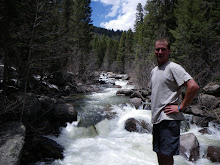I think it's important to note why Baker's is such an interesting run. At times it's reminiscent of the Black Canyon of the Gunnison River and the Upper Taos Box of the Rio Grande in that the entire run is a siphon. As you weave your way through boulder gardens boofing and sliding, you're very cogniscent of the fact that the water disappears under rocks everywhere. I can't think of one rapid that doesn't have at least one siphon looming somewhere. The other issue here is that many good looking options thorugh the boulders lead to danger. Knowing where to go is critical, boating scouting is difficult. and the vertical 35m walls offer little chance to get out and portage.
The Team consisted of Shawn Fuller, Cody Beach, Josh Mack and Scott Dent. We had all been down many times together and with other teams. We know the run well and most of the time, unless I'm outta my boat to shoot pics, we just bomb the run without scouting.
We cruised through the upper sections enjoying a great day with friends. The sun was out, things were going wonderfully and we were in the pool above Boof or Slide. It's here that the river regroups and offers a long section of boulders to weave and boof your way through. Finger Fuck is the final section of boulders in this area. Earlier in the year, a good friend Tony had gotten pinned in the siphon at the top of Finger Fuck...not a good thing. Once you get around the siphon in Finger Fuck and eddy out on the left wall, one more move gets you through it and heading to the eddy above the river wide Siphon.
As I pulled into this eddy, I immediately looked upstream to make sure the Team was on track. Cody had gone down to the Siphon and everyone else was doing good. I needed to make room in the eddy so I pealed out and headed for the last move. As I left the eddy, I quickly glanced back to see if Josh made it into the wall eddy and this is were I ran into trouble. By looking back one more time, it threw off my timing to get through a slot and voila...I broached the right side of the slot's rock sideways with my boat and pinned immediately. I didn't panick, rather I started to rock my boat and use my paddle to apply leverage trying to get weight forward to release my boat. Unforunately, this action only made things worse. My boat pinned with greater force as I was in the middle of current. My boat's hull started to slowly push up towards my knees. I could still move my legs so I moved my knees up to my skirt to make sure I could get out if necessary. I slid them back into the thigh braces and began looking to the Team for help.
They immediately recognzed the issue and got out to help. The first option we tried was hand to hand pulling to see if we could get the boat unpinned.
 | ||
| Trying to pull me and my boat off the rock |
 |
| Giving directions |
Cody had gotten out downstream with a throw rope and was ready to bag me above the Siphon should I come outta my boat and head downstream.
 |
| Nice throw bro !! |
With two ropes on me and my boat, and the Team ready to go, I felt really confident that things were going well. I could feel water entering my kayak from my drysuit/spraydeck combo and I could also feel the boat squeezing my legs more and more. Time to get out. I had my Kokatat drysuit on so I was comfy and warm and well prepared for this. I had been in the water by this time about 4 1/2 minutes and was still clear headed, coherent, and mentally in control. A solid drysuit is key. It kept me warm which allowed all of this to happen. I don't know what would have happened if I had succumbed to hypothermia.
 | |
| 2 Ropes on Me |
 | |
| Finally free :) |
I kicked out the dent on the bottom and checked it for cracks. Not surprisingly the boat was still in good shape. Fluid boats are flipping tough man. A quick thank you, debrief and gathering of gear and we were back in out boats heading downstream.
Looking back at this event, what can I take from it? What did we learn?
1) I let my guard down and didn't take the move seriously. I was too focused on the Team upstream. I had done this move over the years countless times and didn't consider it hard or threatening. Pay attention to every move easy or not. Find an eddy before you look around if you're still in moving current.
2) A strong team with rescue experience is always the case when paddling hard whitewater. Paddle with those you know. Carry the right equipment. Know how to use it.
3) Establish good communication. Make sure everyone knows the signals.
4) Above all, keep your cool. During this whole thing I was pretty calm and collected. It allowed us to manage it efficiently and effectively.
Below is Shawn's helmet cam footage. I wasn't wearing mine this day...
Getting Pinned on Baker's from David Farkas on Vimeo.
Cheers guys for a great day and a great rescue. That's why we paddle together. Thanks to my sponsors for epic gear. Time and time again, we rely on our equipment to help us with safe passage downstream.











































